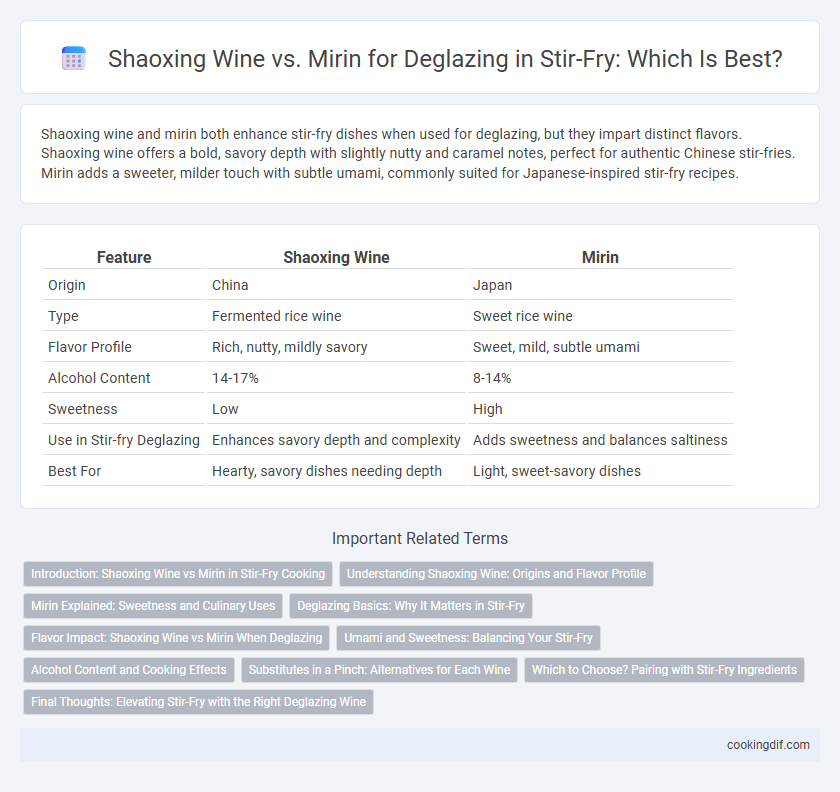Shaoxing wine and mirin both enhance stir-fry dishes when used for deglazing, but they impart distinct flavors. Shaoxing wine offers a bold, savory depth with slightly nutty and caramel notes, perfect for authentic Chinese stir-fries. Mirin adds a sweeter, milder touch with subtle umami, commonly suited for Japanese-inspired stir-fry recipes.
Table of Comparison
| Feature | Shaoxing Wine | Mirin |
|---|---|---|
| Origin | China | Japan |
| Type | Fermented rice wine | Sweet rice wine |
| Flavor Profile | Rich, nutty, mildly savory | Sweet, mild, subtle umami |
| Alcohol Content | 14-17% | 8-14% |
| Sweetness | Low | High |
| Use in Stir-fry Deglazing | Enhances savory depth and complexity | Adds sweetness and balances saltiness |
| Best For | Hearty, savory dishes needing depth | Light, sweet-savory dishes |
Introduction: Shaoxing Wine vs Mirin in Stir-Fry Cooking
Shaoxing wine, a traditional Chinese rice wine, imparts a rich, slightly nutty flavor ideal for deglazing in stir-fry dishes, enhancing umami depth and complexity. Mirin, a sweet Japanese rice wine, offers a mild sweetness that balances savory ingredients but may lack the robust aroma of Shaoxing wine. In stir-fry cooking, choosing Shaoxing wine over mirin results in a more authentic Chinese flavor profile with pronounced savory notes for effective deglazing.
Understanding Shaoxing Wine: Origins and Flavor Profile
Shaoxing wine, a traditional Chinese rice wine from the Zhejiang province, offers a rich, nutty flavor with subtle sweetness and umami notes essential for authentic stir-fry dishes. Its distinct aroma and depth enhance the caramelized fond when used for deglazing, imparting complexity that differs significantly from the sweeter, milder taste of Japanese mirin. Understanding Shaoxing wine's unique fermentation process and its role in regional cuisine enables cooks to elevate stir-fry sauces with balanced acidity and savory richness.
Mirin Explained: Sweetness and Culinary Uses
Mirin, a sweet Japanese rice wine, imparts a delicate sweetness and slight acidity that enhances the depth of flavors during deglazing in stir-fry dishes. Its lower alcohol content and balanced sugar level create a glossy, caramelized finish ideal for glazing vegetables and proteins. Unlike Shaoxing wine, which offers a bolder, savory profile, mirin's sweetness contributes to a harmonious, mellow contrast in Asian stir-fry cooking.
Deglazing Basics: Why It Matters in Stir-Fry
Deglazing with Shaoxing wine or mirin intensifies stir-fry flavors by dissolving caramelized bits left in the pan, unlocking rich umami and sweetness. Shaoxing wine offers a robust, slightly nutty profile ideal for savory Chinese dishes, while mirin contributes a gentle sweetness perfect for balancing delicate Japanese stir-fries. Choosing the right deglazing liquid enhances the sauce's depth, ensuring a well-rounded and aromatic stir-fry experience.
Flavor Impact: Shaoxing Wine vs Mirin When Deglazing
Shaoxing wine imparts a rich, savory depth with subtle nutty and caramel undertones, enhancing the umami profile of stir-fries during deglazing. Mirin, a sweet rice wine, adds a mild sweetness and glossy finish, balancing salty and savory elements with a delicate fruity aroma. Choosing Shaoxing wine intensifies complex savory flavors, while mirin offers a sweeter, lighter touch to the sauce's texture and taste.
Umami and Sweetness: Balancing Your Stir-Fry
Shaoxing wine enhances stir-fry dishes with rich umami and a slightly nutty flavor, creating depth and complexity in the deglazing process. Mirin contributes a sweeter profile with subtle acidity, balancing saltiness and adding a glossy finish to sauces. Choosing between Shaoxing wine and mirin depends on desired flavor intensity and sweetness, optimizing the balance for authentic or mildly sweet stir-fry results.
Alcohol Content and Cooking Effects
Shaoxing wine typically contains about 15-20% alcohol, which evaporates quickly during stir-frying, enhancing the dish's umami and depth without overpowering flavors. Mirin, with a lower alcohol content around 10-14% and higher sugar levels, imparts a subtle sweetness and gloss to sauces while also aiding in deglazing. Choosing Shaoxing wine over mirin results in a more savory profile and less residual sweetness, ideal for authentic Chinese stir-fry dishes that rely on balanced, bold flavors.
Substitutes in a Pinch: Alternatives for Each Wine
Shaoxing wine and mirin both add depth and sweetness in stir-fry deglazing, but when unavailable, dry sherry or sake can substitute Shaoxing wine due to similar umami and aroma profiles. Mirin alternatives include a mix of dry white wine and a touch of sugar or honey to mimic its sweet, syrupy consistency without overpowering the dish. Using rice vinegar with a pinch of sugar also works as a quick mirin substitute, balancing acidity and sweetness essential for authentic stir-fry flavors.
Which to Choose? Pairing with Stir-Fry Ingredients
Shaoxing wine, a Chinese rice wine with a rich, nutty flavor, pairs exceptionally well with savory stir-fry ingredients like soy sauce, garlic, and ginger, enhancing umami notes and depth. Mirin, a sweet Japanese rice wine, is best suited for balancing flavors in stir-fries featuring sweeter elements such as teriyaki sauce or vegetables like bell peppers and carrots. Choosing Shaoxing wine or mirin depends on the desired flavor profile: opt for Shaoxing to deepen savory dishes and mirin to add a subtle sweetness when deglazing.
Final Thoughts: Elevating Stir-Fry with the Right Deglazing Wine
Shaoxing wine offers a robust, nutty flavor profile that enhances the depth of stir-fry dishes, making it ideal for authentic Chinese recipes. Mirin provides a sweeter, milder finish and works well in Japanese-inspired stir-fries, balancing umami with subtle sweetness. Choosing the right deglazing wine depends on the desired flavor complexity and regional authenticity, elevating the stir-fry's overall taste experience.
Shaoxing wine vs mirin for deglazing Infographic

 cookingdif.com
cookingdif.com